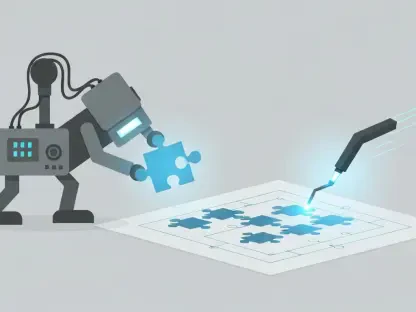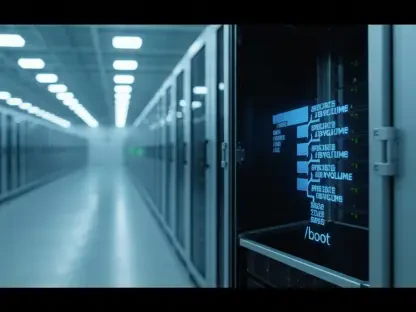In the fast-paced world of DevSecOps, the integration of artificial intelligence (AI) is radically transforming the landscape by seamlessly merging development, security, and operations. Traditional security methods are frequently overwhelmed by the rapid development cycles and complex cloud-native environments that characterize modern software development. AI emerges as a beacon of promise, offering automated solutions for threat detection and vulnerability management while ensuring continuous compliance. This transformational impact is significant, but it also brings potential pitfalls that demand careful navigation. This article delves into these dynamics, exploring how AI is shaping the field of DevSecOps and addressing the balance between increased automation and maintaining robust security.
The Promise of AI in DevSecOps
Artificial intelligence fundamentally alters the approach to managing the labyrinthine complexities of cloud-native environments, offering unmatched potential in enhancing security processes within DevSecOps. The capacity of AI to swiftly automate various actions—from threat detection to vulnerability management and compliance monitoring—stands out as one of its most compelling advantages. By decreasing the frequency of false positives, AI not only refines security interventions but also ensures a more efficient coverage of critical infrastructures, allowing organizations to safeguard their assets effectively. These automations expedite security operations and enable IT personnel to allocate their time and efforts towards more intricate issues.
A critical element that AI brings to the table is its capability to analyze immense volumes of telemetry data in real time, which is indispensable for identifying anomalies and predicting breaches. Such capabilities allow security teams to prioritize genuine threats and vulnerabilities more effectively, bypassing redundant manual tasks. AI’s prowess in fast-paced, real-time data analysis leads to a proactive security posture, which is invaluable in preemptively addressing potential security threats. By managing these dynamics with precision, AI empowers security professionals to avert incidents before they escalate, thus ensuring an agile response framework aligned with the modern threat landscape.
Challenges and Risks in Zero-Trust Integration
Although the integration of AI into DevSecOps carries numerous benefits, aligning it with a zero-trust security model reveals considerable challenges that must not be overlooked. The zero-trust model’s fundamental assumption is that no entity, whether internal or external, is inherently trustworthy, thus requiring a vigilant and comprehensive deployment strategy for AI technologies. While AI enhances security through advanced enforcement capabilities, over-reliance on automated systems can introduce critical blind spots. This vulnerability is particularly acute in recognizing sophisticated threats such as zero-day vulnerabilities, which can evade detection by overly mechanized systems.
Furthermore, AI-driven security measures may inadvertently misclassify benign activities as malicious, prompting unnecessary alarm and potential procedural disarray. These misclassifications can lead to lapses in security protocols, thereby compromising the integrity of security efforts. The intricate relationship between AI capabilities and zero-trust validates the caution expressed by security experts, emphasizing the need for thorough awareness of AI’s limitations. A balanced strategy, underpinned by human awareness and involvement, is indispensable for bridging the gap between over-dependence on AI and the rigorous security mandates of a zero-trust architecture.
Balancing Compliance and Flexibility
Regulatory compliance remains a cornerstone of effective security strategies, yet aligning it with the required flexibility in DevSecOps introduces its own complexities. AI offers a potent means to automate compliance checks across vast infrastructures, ensuring adherence to standards and regulations such as FedRAMP, NIST, and ISO 27001 at unprecedented scales. Despite this ability, AI may inadvertently overlook specific security gaps unique to various operational contexts, leading to potential compliance failures. The challenge lies in harmonizing AI-driven compliance mechanisms with the nuanced realities of specific environments.
Essential to overcoming these challenges is the combination of AI’s efficiency with human oversight. Integrating human intervention in governance, risk management, and compliance (GRC) processes is critical to bridging gaps that AI may not address. Organizations are prompted to employ AI-driven compliance solutions tailored with human judgment to maintain regulatory integrity while abiding by adaptive protocols. By ensuring collaborative interplay between AI automation and human validation, entities can cultivate a robust, adaptable security posture capable of meeting both regulatory demands and dynamic operational needs.
AI Models: The Risk of Bias and Exploitation
The effectiveness of AI models in DevSecOps can be compromised by the biases present in their training datasets, posing notable security risks. Attackers are known to exploit these biases through adversarial machine learning techniques, which can undermine the stability and reliability of AI systems. The risk of such adversarial exploitation exemplifies challenges where AI intends to bolster security outcomes but can instead introduce vulnerabilities if biases remain unchecked and unaddressed.
Continuous data validation and adversarial testing emerge as integral components in maintaining the effectiveness of AI. By methodically addressing these biases, organizations can thwart malicious attempts to manipulate AI systems and ensure their long-term reliability. Regularly refining AI models and prioritizing fairness in datasets mitigate the risks of bias exploitation. In advancing AI’s security contributions, such interventions are indispensable in fortifying AI-driven systems against potential threats while sustaining a proactive stance in their operational contingencies.
DevOps and AI in Development
Artificial intelligence revolutionizes DevOps practices, offering compelling enhancements to software development cycles through increased velocity and improved integration processes. AI-infused DevOps, commonly referred to as AIOps, leverages machine learning to improve code creation, anomaly detection, and predictive maintenance capabilities, thereby significantly enhancing the timelines and quality associated with software deployments. These AI-driven innovations empower DevOps teams to expedite infrastructure provisioning and streamline security assessments, resulting in agile delivery operations.
Despite these advancements, the role of AI within DevOps is not devoid of challenges. AI’s reliance on existing data patterns may inadvertently introduce compliance inadequacies or misconfigure important aspects of code and infrastructure. Unsupervised AI systems can unknowingly embed security vulnerabilities in generated code, triggering potential compliance breaches and infrastructure misconfigurations. Navigating these risks necessitates concerted human oversight in ensuring that AI-driven DevOps retains its focus on security integrity and operational compliance. By maintaining diligent review protocols and encouraging collaborative engagement between AI mechanisms and human insight, organizations can optimize DevOps processes while safeguarding against security compromises.
Ensuring AI’s Dual Edge is Managed
Effectively managing AI within DevSecOps requires strategic balance, given its capacity to both significantly bolster and potentially complicate security efforts. While AI offers transformative benefits in automating security operations and compliance initiatives, the necessity of human oversight remains a cardinal tenet. This oversight assists in counteracting the limitations and inaccuracies intrinsic to machine-based systems, ensuring that AI serves as an enabler rather than a threat to security objectives. AI-augmented reviews and context-aware access controls are strategic solutions that organizations can implement to harness AI’s full potential while mitigating its risks.
By embedding AI within a well-defined framework comprised of strategic human controls and oversight measures, organizations can achieve a critical equilibrium that maximizes the advantages AI offers while minimizing potential drawbacks. Such an approach ensures that AI continues to augment DevSecOps initiatives, effectively contributing to organizational security targets. Guarding against the pitfalls of unsupervised automation requires a vigilant approach, fostering AI’s role as an asset rather than a liability within the broader security landscape.
The Role of Human Intervention in AI Adoption
The integration of AI into security practices demands a careful understanding of the extent to which AI should operate autonomously versus its reliance on human judgment and intervention. AI’s efficiencies in processing and analyzing data at unprecedented speeds are undeniable, yet the complexity and variability of security challenges still require keen human supervision. Human intervention acts as a crucial line of defense against potential oversights or errors that AI systems might introduce, thereby ensuring the reliability and accuracy of automated processes within DevSecOps.
Achieving the optimal synergy between human expertise and AI capabilities involves deliberate and strategic planning. Human oversight complements AI’s automation, allowing for greater adaptability and responsiveness to emerging threats and regulatory changes. This partnership ensures that AI systems remain oriented towards achieving security compliance and operational excellence. Through continuous feedback loops and iterative improvements, human intervention consolidates AI’s role within DevSecOps frameworks, collectively enhancing organizational resilience and security integrity against evolving cyber threats.
Conclusion
Reflecting on the current landscape where AI intersects with DevSecOps, it’s evident that AI, while advantageous in many respects, must be judiciously managed to ensure a harmonious relationship between automation and security. AI’s role is far from being a standalone security solution; rather, its implementation demands a cohesive integration with human insight and judgment. Organizations willing to invest in this human-machine collaboration stand to benefit immensely, transforming AI into a force multiplier that amplifies security effectiveness and compliance capabilities. The true challenge and opportunity lie in crafting a framework where AI complements human expertise, adapting to complex security environments and navigating the nuanced demands of modern compliance with agility and precision. Embracing AI within this balanced paradigm promises continued innovation and strategic security advantage for DevSecOps initiatives moving forward.









